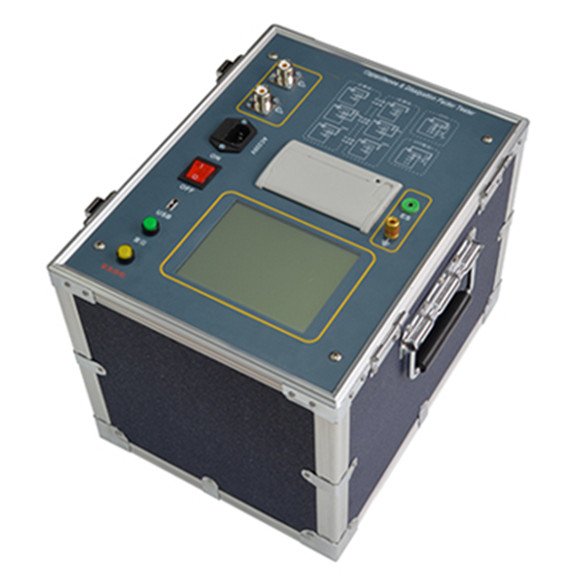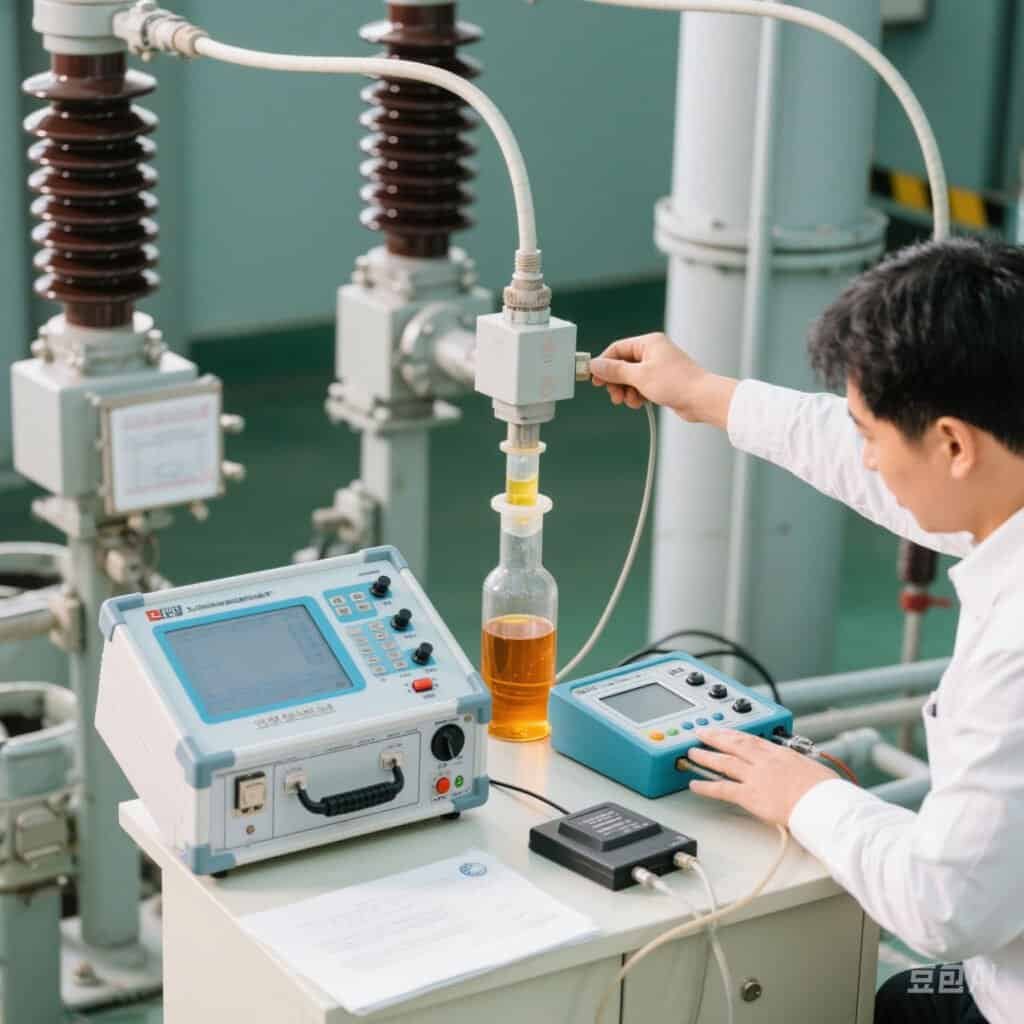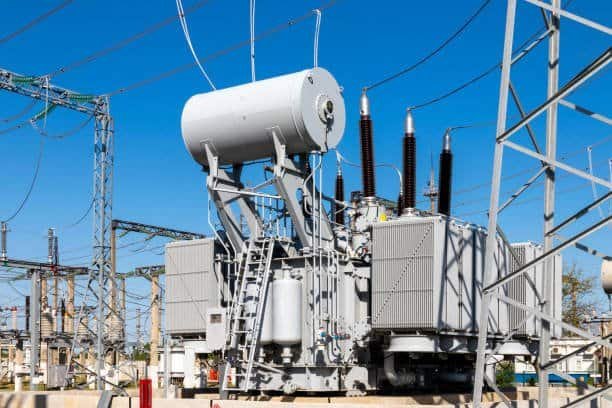In power equipment insulation condition assessment, 10kV dielectric loss test and oil dielectric loss test are both important insulation inspection means in power system. 10kV dielectric loss test and oil dielectric loss test have their own focus, and their effectiveness should be judged according to the specific scenarios and inspection objectives. The following is the specific analysis and comparison:
1. Measurement Method, Advantages, Disadvantages, and Applications
What is dielectric loss test ?

10kV Dielectric Loss Testing
10kV dielectric loss test (Tan delta test) measures the tangent of the dielectric loss angle (tanδ) at high voltage (10 kV) and is primarily used to assess the insulation performance of high-voltage electrical equipment, such as transformers, cables, and reactors.
This test helps determine if the insulation has moisture and evaluates the overall condition of the insulation materials. It identifies potential defects, such as moisture ingress, aging, and partial discharge. The underlying principle is that insulating materials lose energy when subjected to AC voltage, and the dielectric loss factor indicates the extent of this loss.
- Advantages: Highly sensitive to the deterioration of solid insulation materials (e.g., cable paper, epoxy resin) and capable of evaluating the overall performance of composite insulation systems.
- Limitations: If equipment failure is primarily due to oil degradation (e.g., metal particle contamination), some issues may be overlooked due to residual insulation performance.
Preferred Scenarios for 10kV Dielectric Loss Testing:
- Preventive testing of oil-immersed equipment (e.g., transformers, requiring a power outage).
- Insulation assessment of dry-type equipment (e.g., dry-type transformers).
- Suspected delamination of insulation materials or partial discharges.
What is Oil Dielectric Loss Test ?

Oil Dielectric Loss Testing
Oil dielectric loss testing focuses on the insulating oil used in oil-filled power equipment. Insulating oil plays a crucial role in insulation, heat dissipation, and arc extinguishing. The dielectric loss value is a key indicator of oil quality.
This test measures the dielectric loss factor of insulating oil under a specific electric field strength to assess the oil’s quality and contamination level.
- Advantages: Directly reflects the chemical condition of the insulating oil (e.g., elevated acidity, increased carbon content) and is sensitive to micro-water content and impurities.
- Limitations: Cannot detect localized defects in solid insulation or at the oil-paper composite interfaces.
Preferred Scenarios for Oil Dielectric Loss Testing:
- Periodic monitoring of transformer oil during operation (sampling can be conducted under live conditions).
- Rapid aging of oil (e.g., operating equipment under high-temperature conditions).
- Verification of the effectiveness of oil treatment processes (e.g., filtration, regeneration).
II. Key Functional Difference of 10kV Dielectric Loss Test and Oil Dielectric Loss Test
| Test Type | 10kV Dielectric Loss Test | Oil Dielectric Loss Test |
|---|---|---|
| Detection Object | Equipment overall insulation system (solid + liquid insulation) | Insulating oil (liquid medium) |
| Test Voltage | 10kV AC high – voltage | Low – voltage (usually ≤ 2kV) |
| Core Parameters | tanδ (dielectric loss factor) and capacitance change | tanδ of insulating oil and electrical conductivity |
| Reflected Problems | Overall aging, moisture absorption, and delamination defects of insulating materials | Oxidation, pollution, water content, or particles of oil quality |
III. Comparison of Efficiency and Maneuverability
| Dimension | 10kV Dielectric Loss Test | Oil Dielectric Loss Test |
|---|---|---|
| Test Cost | High (requires special high – voltage equipment and power – off operation) | Low (laboratory analysis is sufficient) |
| Implementation Difficulty | Complex (requires a professional high – voltage test team) | Simple (send for inspection after oil sample collection) |
| Timeliness of Results | Obtain data on – site within a limited time | Depend on the laboratory cycle (usually 1 – 3 days) |
IV Typical Synergistic Application Cases
Example: Oil-Immersed Transformer
- If the oil dielectric loss test indicates that the tanδ exceeds the standard, it suggests that the oil quality is deteriorating, and oil filtration treatment should be prioritized.
- If the oil index remains abnormal after treatment, conduct a 10kV dielectric loss test. If the overall tanδ shows no improvement, it may indicate aging of the solid insulation (e.g., cardboard), necessitating further assessment of the winding insulation.
V. Effectiveness Depends on the Target Scenario
Situations Where Oil Dielectric Loss Testing is More Useful:
- Quick assessment of oil condition is needed.
- Limited budget for equipment maintenance, prioritizing low-cost monitoring.
- Equipment with oil-dominated insulation (e.g., older oil circuit breakers).
Situations Where 10kV Dielectric Loss Testing is More Useful:
- Acceptance testing for newly commissioned equipment or post-overhaul assessments.
- Comprehensive condition diagnosis of composite insulated equipment.
- Suspected defects in solid insulation (e.g., cable terminations).
Conclusion
10kV dielectric loss testing and oil dielectric loss testing are critical insulation assessments in power systems. The 10kV dielectric loss test provides a comprehensive evaluation of the transformer’s insulation system, considering the performance of the entire insulation structure, including winding insulation, core insulation, and insulating oils under actual operating voltage.
This test identifies issues such as moisture ingress, aging of winding insulation, and overall insulation defects, which may arise from various factors like thermal aging during prolonged operation, ambient humidity, and changes in insulation material properties. Timely detection and resolution of these insulation problems are essential for preventing sudden insulation failures in transformers and ensuring the stable operation of power systems.
In cases of limited resources, prioritizing the 10kV dielectric loss test is indeed more reasonable, as it provides a more direct reflection of the overall health of the transformer insulation system.






